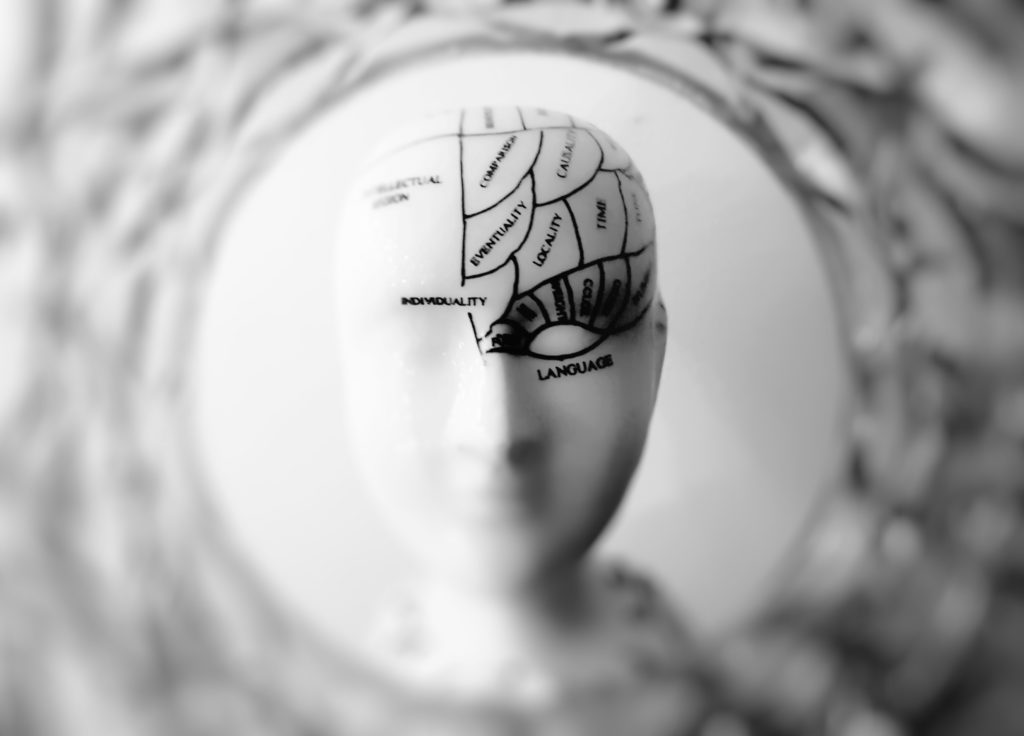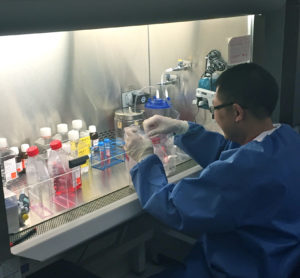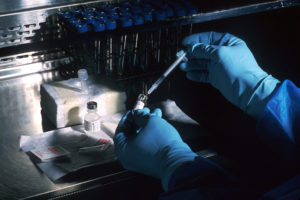CAR-T cell Therapy: A type of treatment in which a patient’s T cells (a type of immune system cell) are changed in the laboratory so they will attack cancer cells. T cells are taken from a patient’s blood. Then the gene for a special receptor that binds to a certain protein on the patient’s cancer cells is added in the laboratory. The special receptor is called a chimeric antigen receptor (CAR). Large numbers of the CAR-T cells are grown in the laboratory and given to the patient by infusion.
If you keep up with medical-related news, you’ve very likely heard of the term “CAR T-cell therapy” by now. Indeed, you may even be one of the numerous individuals who’ve reached out to NBTS already to ask about this emerging type of immunotherapy technique, and its possible use in brain tumors. CAR-T cell therapy has become the new “hot topic” in cancer research and news, garnering features in every major media outlet, and even receiving the coveted distinction as the American Society for Clinical Oncology’s “Advance of the Year” for 2017.
So, what is this new type of treatment grabbing all the headlines in science and health news?
Basic Overview
Type of Treatment
CAR T-cell therapy – short for chimeric antigen receptor T-cell therapy – is a type of immunotherapy (or sometimes classified as a “gene therapy”). More specifically, it is part of a class of immunotherapies called “adoptive cell immunotherapy” (also sometimes referred to as “adoptive cell transfer” or “adoptive celChimeric Antigen Receptor T-cell therapy, or CAR-T cell therapy for short, is a type of immunotherapy. Immunotherapy is a treatment strategy that seeks to harness the cells of the human immune system to detect and destroy cancerous tumors. In CAR-T cell therapy, specifically, researchers collecting a patient’s own T cells (a type of white blood cell that serves as the backbone of the immune system) and re-engineer them in the laboratory to recognize and engage with specific proteins found on the surface of cancerous cells called “tumor antigens.” In CAR-T cell therapy, each treatment is personally made. CAR-T cell therapy is also often considered a “cell-based gene therapy,” or just “gene therapy,” because it involves altering the genes inside T cells to help them attack the cancer.
Treatment Overview
CAR T-cell therapy uses a patient’s own T cells, which have been genetically “re-programmed” in a laboratory to fight cancer cells. T cells are removed from a patient, armed with a new protein that allows them to recognize cancer, and then are given back to the patient in large numbers to identify, find, and destroy the cancer cells.
Scientific Overview
T cells are a type of white blood cell often referred to as “hunter” cells and the “workhorses” of the immune system, for the pivotal role they play in attacking diseased cells within the body.
The immune system monitors our body, watching for “invaders” or foreign substances, molecules, or cells they do not recognize as normal or healthy. The typical way that the cells of our immune system – T cells included – recognize things that don’t belong in the body is by scanning for specific proteins on the surface of those cells. These proteins are called “antigens” (and are the “A” in “CAR”) and act as targets or markers for the immune system to go after. Immune cells like T cells have their own proteins on their surfaces called “receptors” (the “R” in “CAR”) that can grab, or bind, onto foreign antigens and trigger an attack against them.
Antigens, are highly specific and need the right corresponding receptor to allow binding (think of a lock, and how it requires the right key to be opened). Therefore, if the immune cells don’t have the right receptor they cannot “see” the antigens marking a diseased cell. Thus, if immune cells like T cells don’t have the right receptor, they can’t find cancer cells’ antigens to attach and help destroy it. And because cancer is a corruption of, or breakdown in, our bodies’ own normal processes, and not a foreign invader like a germ, bacteria, or virus, our immune system often doesn’t have the right receptor to recognize them as bad.
In CAR-T cell therapy, the T cells that are extracted from the patient get engineered in the lab to sprout a synthetic, or man-made, receptor that allows them to identify antigens that cancer cells produce. These modified T cells are referred to as “chimeric” (the “C” in CAR), meaning they are not naturally-occurring. The receptors are the CARs – Chimeric Antigen Receptors – and the new cells in full are the CAR-T cells. Since different cancer types have different antigens, each CAR-T cell is made for that specific target found on cancer cells, but not normal cells. The new CAR-T cell can now seek out and destroy cells that have the tumor-specific antigens on them.
Quick History
While CAR-T cell Therapy is considered a “new” approach to cancer treatment, the research behind it has been in the works for decades, going back nearly 30 years to the early 90’s when scientists began exploring new techniques to engineer cells. Further, the history of immunotherapy as a theory, or concept, for potential cancer treatment dates even farther back to the turn of the 19th century, when doctors first noticed that some cancer patients who developed infections had spontaneous improvement in their conditions, indicating that perhaps the activation of the body’s innate immune system could play a role – if triggered correctly – to fight cancer.
CAR-T cell therapy really began to pick-up steam and grab attention about five years ago, when early clinical trials of the approach in certain blood cancers showed remarkable results in certain patients. In fact, NBTS covered updates on CAR-T cell research for glioblastoma back in both our 2015 and 2016 recaps from Annual Meetings of the Society for Neuro-Oncology.
Fast forward to 2017, and the first two CAR-T cell therapies were approved by the FDA. In September, a CAR-T cell therapy called Kymriah (tisagenlecleucel) was approved for some children and adults (up to 25-years old) with acute lymphoblastic leukemia (ALL) that has relapsed. Then just a month later, in October 2017, use of Yescarta (axicabtagene ciloleucel) was approved for certain patients with large B-cell lymphomas, who’ve failed two or more standard treatments. In trials for the lymphoma drug, an astounding 50 percent of patients saw their cancer disappear completely, and stay gone.
How Does it Work?
The process for this treatment takes some time – anywhere from approximately a week to a few weeks, depending on the laboratory a patient’s medical team is working with.
First, the T cells must be extracted and isolated from a patient’s blood. To do this, patients go through a process called apheresis. Similar to a dialysis procedure, patients must sit, lie, or recline in a bed or chair and remain still for a few hours while blood is removed through one IV line and then returned through another. After the white blood cells are extracted, T cells, specifically, are separated, sent to the lab, and genetically altered to produce the CAR. Researchers use a “viral vector” to deliver genetic material into cells, which instructs the T cells to grow the needed receptor. This makes them CAR-T cells. Since a large number of CAR-T cells are needed for the therapy to be effective, it can take some time for the lab to create, grow, and multiply enough of them.
Once they have enough new CAR-T cells, they are frozen and delivered back to the patient’s medical team. The doctors then thaw and subsequently infuse the CAR-T cells back into the patient through an IV line. With guidance from their engineered receptor, these CAR-T cells seek to recognize and launch a precise attack against the cancer cells that harbor the antigen target on their surface.
Potential Use in Brain Tumors
Because of their ability to induce some dramatic survival improvements in blood cancers, the CAR-T cell therapy approach is now also being studied for brain tumor patients – beginning in the area of highest unmet medical need, and the most aggressive brain tumors, like glioblastoma and DIPG/DMG.
Most recently, in mid-March 2024, three separate papers were published in high-impact scientific journals which described preliminary results from small, early-phase clinical trials of CAR-T cell therapy in brain cancer.
Each trial used a slightly different approach to CAR-T cell therapy, and were studies in different patient settings. Together, these reports received a significant amount of media coverage from outlets ranging from CNN to Fox News. Below is a quick breakdown of each study, and what it showed:
City of Hope/Mustang Bio
- A study led by researchers at City of Hope Medical Center in Los Angeles, CA, and sponsored by the biopharmaceutical company, Mustang Bio, evaluated IL-13Rα2-targeting CAR-T cells in a phase 1 clinical trial of 65 patients with recurrent high-grade glioma (HGG), the majority being recurrent glioblastoma.
- IL-13Rα2 is a protein (antigen) that is reported to occur on the surface of HGG cells, but not healthy cells.
- This trial tests three different approaches to delivery CAR-T cell therapy and in different doses as well as by different manufacturing procedures.
- Overall, their approach was found to be feasible and reasonably well-tolerated by patients.
- The researchers were able to determine in the study an optimal approach to manufacture each patient’s treatment, as well as the delivery method. But the optimal dose has not been found yet, and is still being refined ahead of a potential phase 2 trial.
- Stable disease or better was achieved in 50% (29/58) of patients eligible for assessment, with two partial responses (partial tumor shrinkage), one complete response (full tumor shrinkage) and a second complete response after additional CAR-T cycles off the trial. For patients with rGBM on the trial, median overall survival for all was 7.7 months and in the arm where optimal manufacturing and delivery was confirmed it was 10.2 months.
- Researchers also observed additional indications that the CAR-T cells were inducing an immune response against the tumor.
- They concluded that, “These findings demonstrate that locoregional IL-13Rα2-targeted CAR-T therapy is safe with promising clinical activity in a subset of patients.”
- Their trial is still active, but not recruiting new patients at this time.
Massachusetts General Hospital
- A study led by researchers at Massachusetts General Hospital is evaluating an approach they call “CARv3-TEAM-E T cells” in a small, pilot phase I trial, of which they reported results from the first 3 patients with recurrent glioblastoma.
- Their CARv3-TEAM-E T cells target the antigen produced by a common mutation found in GBM called EGFRvIII, as well as normal EGFR proteins on tumor cell surfaces.
- They delivered the treatment through an infusion into the ventricles of patients’ brains.
- They reported that a single infusion caused “”dramatic and rapid” shrinking of tumors based on viewing MRI images within days after treatment in all patients, with one patient having a near-complete response and the other two having partial responses.
- They also reported their approach was reasonably well-tolerated by patients.
- However, despite the dramatic initial responses, all three patient’s tumors eventually progressed.
- Their trial, called INCIPIENT, is currently ongoing and still recruiting patients – however, only at MGH,
University of Pennsylvania Perelman School of Medicine
- A study led by researchers at the Abramson Cancer Center at Penn is evaluating a CAR-T cell approach that targeted both EGFR and IL-13Rα2 in a small phase 1 clinical trial of recurrent glioblastoma patients. They reported interim results from the first 6 patients, for which two different dose levels were studied.
- At both dose levels, patients experienced early-onset neurotoxicity that required management with high-doses of steroids. One patient was unable to continue at the higher dose level.
- Researchers observed reductions in tumor volume on MRIs of all six patients shortly after treatment, however these were not significant enough to meet response criteria.
- Additional analysis of samples from fluid draws from these patients indicated that an immune response was occuring.
- They conclude, “These first-in-human data demonstrate the preliminary safety and bioactivity of CART-EGFR-IL13Rα2 cells in rGBM. An encouraging early efficacy signal was also detected and requires confirmation with additional patients and longer follow-up time.”
- Their trial is active and recruiting, however only at Penn.
There’s also significant work happening to study the potential of CAR-T cell therapy for children and adolescents with aggressive brain tumors like DIPG and other diffuse midline gliomas.
Potential Side Effects and Other Considerations
Side Effects
Like any cancer treatment, CAR-T cell therapy can cause serious – even fatal – side effects. Some of the most worrisome safety issues seen to-date in human trials and treatment with CAR-T cells are a syndrome known as cytokine release syndrome (CRS), which can lead to dangerously high fevers and major drops in blood pressure, and neurological symptoms like brain swelling (edema). Some of these symptoms have even caused companies developing CAR-T cell therapies to halt or pause development.
However, these issues appear limited and often reversible, and researchers and doctors are beginning to learn how to better manage and treat these side-effects. In fact, a drug called Actemra (or tocilizumab) was identified and is now often used to treat CRS.
Cost
Prices for these cutting-edge new treatments to-date have been set very high. For example, the cost for a complete course of Kymriah has been set $475,000 (before insurance). This continues a trend in high-pricing models for new cancer immunotherapies and is an issue any patient considering these treatments needs to discuss with their medical team and insurance providers.
Applicability
Tumor-specific antigens in cancers like glioblastoma are not as easy to identify as some blood cancers. For example, one of the lead antigens for glioblastoma CAR-T cell therapy, EGFRvIII, is only found in about 30% of glioblastoma patients. Therefore, only those with this specific mutation would likely receive (or even be eligible) for this CAR-T cell treatment.
Efficacy and Durability
Even in the trials with the best results of CAR-T cells in blood cancers that led to the approvals noted above, not every patient responded to the therapy.
“There is definitely room to improve,” said Dr. Terry Fry of the NCI, who has been involved in much of the work with CAR-T cell therapy and blood cancers. Even those who experience a complete response, up to a third will see their disease return within a year, Dr. Fry said. Many of these disease recurrences have been linked to ALL cells’ no longer expressing the target antigen over time, a phenomenon known as antigen loss.
Conclusion
It’s still early stages for our understanding of if, and how, CAR-T cell therapy can work for brain tumors. Early clinical trial results to date have demonstrated the feasibility of this approach – and that it certainly warrants more investigation – but also potential limitations and challenges. While some remain skeptical that the CAR-T cell therapy approach can be applied as successfully in brain tumors as it has to date in blood cancers, others remain hopeful and speak of a “cause for optimism,” that the hurdles to making CAR-T cell therapy successful for brain tumors don’t appear to be insurmountable and are many of the same issues the field is working on for other solid tumors.
If you are interested in participating in CAR-T cell therapy trials currently happening in glioblastoma, DIPG, or any other brain tumor type – or simply learning more about them and the options – please speak to your medical teams and/or visit the NBTS Clinical Trial Finder to identify opportunities to discuss with your doctors.
Updated on August 7, 2024 to reflect results from the most recent CAR-T cell trial reports in brain tumors.





